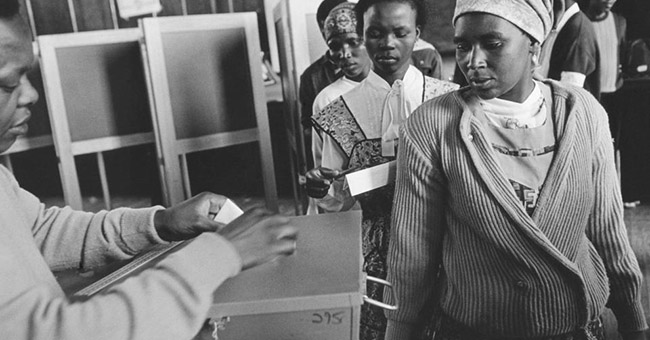
This article was first published by www.enca.com on 26 April 2014.
Half a lifetime ago, on 27 April 1994, I made a mark on a sheet of paper which was longer than it was wide. I was one of millions who did the same, and for most of us it was our first time. Because of the incredible change those small marks could inaugurate, it was difficult not to think of yourself and those around you as the focus of larger forces. History was on our side. Fate loved us. And the Archbishop told us G-d was favouring us.
At twenty-one I had started my first full-time adult job as an instructor at a historically white South African university where I had registered as an undergraduate the day after Nelson Mandela’s release from prison. The four years of political transition which had passed between that Sunday in February and the day of voting were harrowing, even from the relative comfort of university studies.
These years were blighted by the double-speak and evasions of the last apartheid government and its embroilment in ‘third force’ destabilisation of townships and rural areas where the Black majority lived.
The white supremacist racists of the extreme right wing had stormed the negotiations with Panzerwagen. And until the middle of 1993, it was unclear to many how and at what cost apartheid would or could be abolished.
Towns and townships lent their names to unspeakable horrors: Boipatong, Katlehong, Sebokeng, Bisho (still spelt that way, then), and the infamous Natal Midlands. Even some churches and taverns in white suburbs did not escape this macabre process. It felt as if the madness of late 1980s South Africa, at the time under stringent State of Emergency legislation, had been intensified. The white minorities placid suburban lives contrasted sharply with the violent conflagration unleashed on Black township residents by P.W. Botha’s government. The white university campus’s superficially calm environs, juxtaposed with the running battles in the nearby townships, starkly expressed this divide. News broadcasts felt like nightly records of death tolls.
While many remember 1994 as one of historic change, some recall the year before it with equal weight. The assassination of Chris Hani in April 1993 presented South Africa with a choice: jump over the precipice into the cauldron of violence, or back away from the edge of madness. The astute political leadership of Nelson Mandela and Oliver Tambo, among others, steered us back from the brink. Tambo’s death days after Hani’s stunned those who had expected his return from exile to presage his election as South Africa’s first democratic president.
In the weeks around those two deaths in 1993, I was being educated in critical literacy, subjecting myself to the rituals of close textual reading with a tutor whose work has remained invaluable to my life as a citizen of post-apartheid South Africa. For a semester, J.M. Coetzee took six of us through the processes of reading the eighteenth century novels of Daniel Defoe, Samuel Richardson, Henry Fielding and Laurence Sterne.
With quiet dignity and droll humour, Coetzee insisted on connecting our reading about worlds distant in time and space with the intimate events we were living through. Based on our understanding that choice rendered beings fully human, we were asked as young post-apartheid South African students to relate how our self-image linked us with the writers of Enlightenment Europe. Coetzee demonstrated how colonial conquest and its representation in novels of the ‘Sentimental Age’ gave his white ancestors fully human status at the same time as it degraded and devalued people of colour.
Thus, when it came to making a choice - paradoxically secret in execution but public in symbolism and effect - casting my vote for the African National Congress on 27 April 1994 was my way of asserting my humanity against the apartheid state’s insistence that I was less than human.
In the weeks prior to the election, we followed news events of the political tensions between the Inkatha Freedom Party and the ANC, the bloodshed of the Natal Midlands, the horrors of urban conflicts in mining companies’ hostels, and rumours and denials of ‘third force’ activity unleashed by the violent and highly militarised apartheid security forces.
At the time I was inducting young South Africans, some of whom would be first time voters, into the rituals and value of critical analysis -- leading discussion classes on the work of South African writers like Njabulo Ndebele and Nadine Gordimer, teaching the granddaughter of the most famous political prisoner who would within days of that election be inaugurated as the first Black president of South Africa... In retrospect it all fits together as a compelling story; but at the time these were just fragments of daily life.
On 26 April 1994 one country had not yet ceased to exist, and another had not yet been born. By the time the results clearly indicated an electoral victory for the ANC, we had collectively stepped away from a South Africa of nightmare and uncertain hope towards another many of us had only dared to imagine.
As we mark twenty years of freedom, we must remember that on that day we stood on the shoulders of a giant of a man, looking towards a future we now inhabit. That man, who J.M. Coetzee recently eulogised as one of the last great men of history, was Nelson Rolihlahla Mandela. Beyond recollection of where we were and what we were doing on that day of democracy’s dawn, or in the days before it, and the days after, we may wish to ask what form our dance of celebration should take to honour his legacy.
Most importantly, now that we can no longer stand on his shoulders, we must ask ourselves how we can ensure that we celebrate twenty more years of freedom, with its textures of equality and fraternity.
 SLiPStellenbosch Literary Project
SLiPStellenbosch Literary Project 